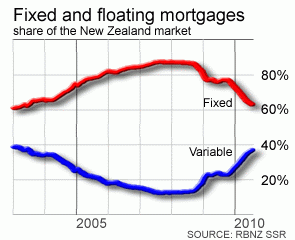
New Zealand homeowners' love affair with fixed-rate mortgage contracts looks like it is coming to an end.
Data released today by the RBNZ shows that mortgages on fixed-rate terms at the end of July 2010 account for 63.2% of all mortgages, down from 87.3% in December 2007 at the height of the housing boom.
Variable rate mortgages now account for 36.8% compared with just 12.7% in December 2007.
The transition is gaining momentum, with monthly changes approaching 1% market share.
The overall market measured by this RBNZ data is $163.9 billion owing for residential mortgages, equivalent to 87.5% of New Zealand's annual GDP.
There are 664,000 floating rate mortgages, and 722,000 fixed rate mortgages in the banking system as at July 2010, although many properties will have more than one registered against them.
The populatity of fixed or floating mortgage products undoubtedly relates very directly to the interest rates applying. Over the past ten years lower interest rates have applied to fixed rate contracts than variable rate ones, as banks piled into cheap international credit sources.
However, from 2010 this situation has reversed as the RBNZ drove its OCR down to 2.5% from July 2008 to May 2009 and cheap foreign credit lines either dried up or came with new costly premiums.
Recently, market watchers see the RBNZ holding off raising the OCR for most of the rest of this year. And wholesale swap rates, although falling, may stay at a premium to floating rates. If these trends hold, an even greater proportion of mortgage could shift to variable rate terms.

We welcome your comments below. If you are not already registered, please register to comment.
Remember we welcome robust, respectful and insightful debate. We don't welcome abusive or defamatory comments and will de-register those repeatedly making such comments. Our current comment policy is here.